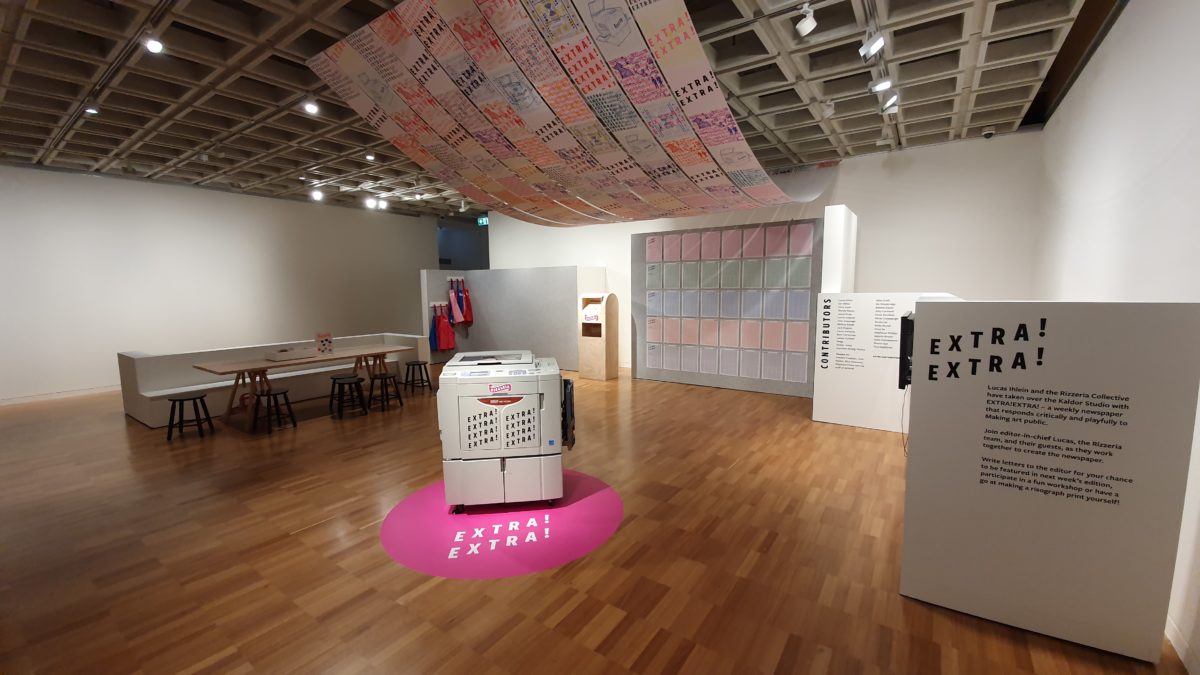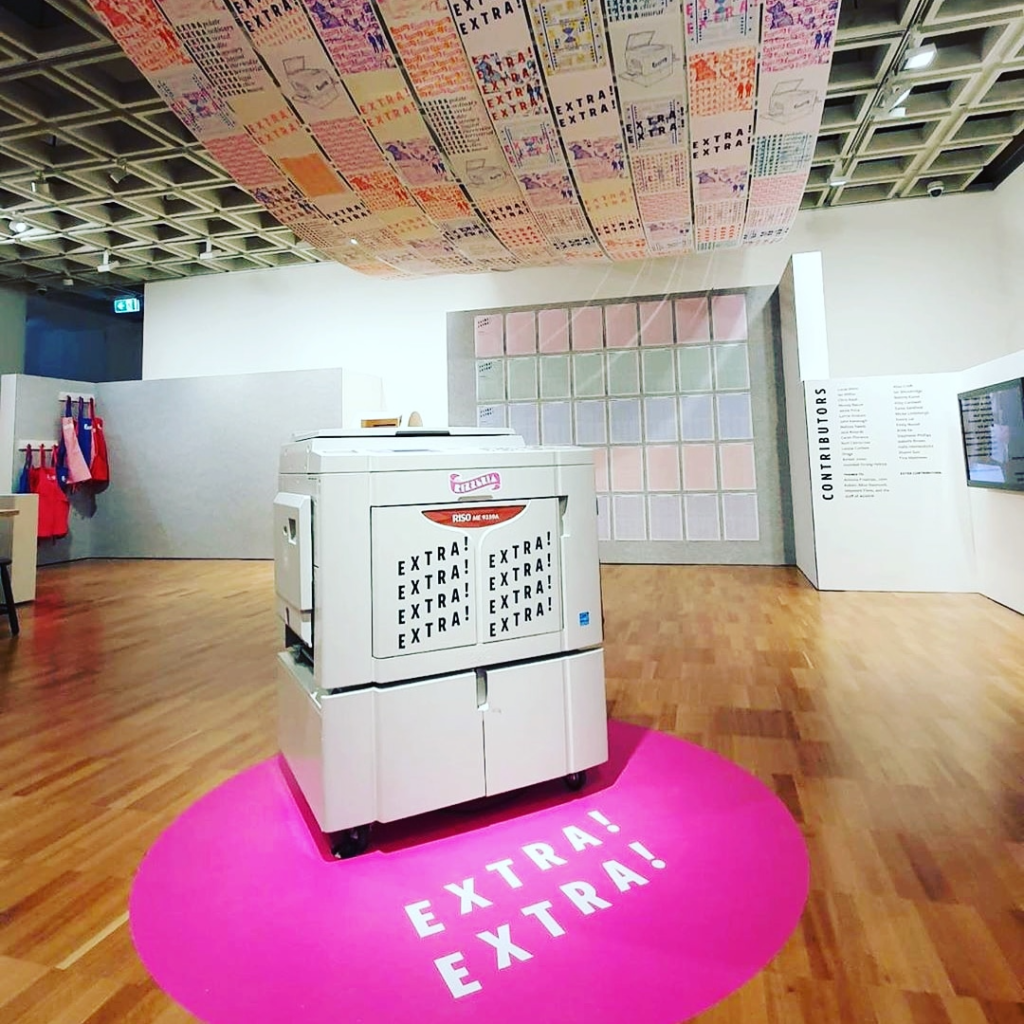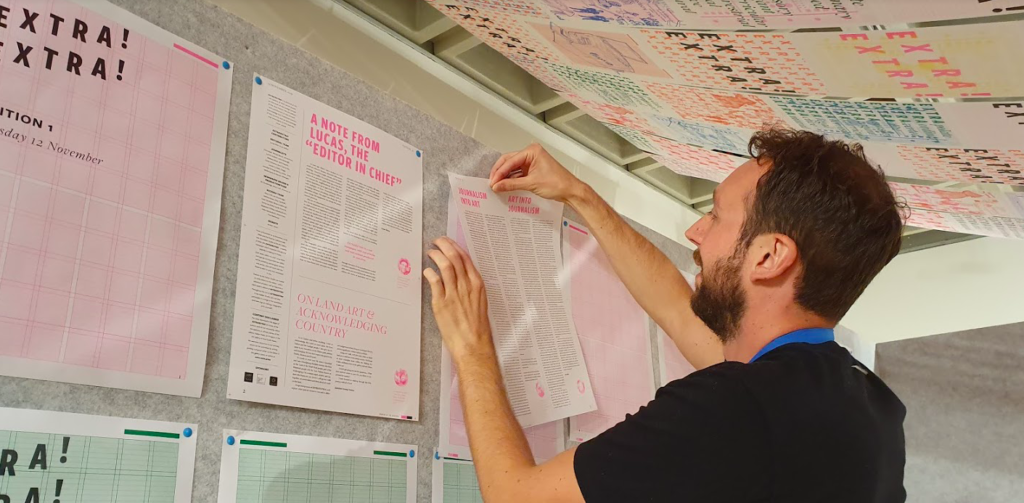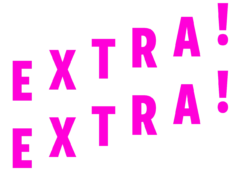
—TO READ MEDIA RELEASE CLICK HERE—
The EXTRA! EXTRA! live newspaper production workshop is on show at the Kaldor Studio, Art Gallery of NSW, lower level 2.
Dates: November 9 to December 15, 2019, 7 days a week, 10am-5pm
Each day from 11am-3pm, Rizzeria Team Members will be in the workshop to demonstrate how the risographic duplicator machine works, and assist you to make your own riso print to take away with you.
On Mondays, the design and editorial team will be working on site preparing each week’s newspaper to go to press.
On Tuesdays, we will be printing the newspaper and pinning it up.
Come and watch the process in action.
On Fridays, the editorial team will be in the Kaldor Studio preparing material for the following week’s newspaper.
On selected days we will also have guest artists and journalists in residence:
Tues November 12: Boni Cairncross and Louise Curham, looking at live art, archiving and audience experience.
Friday November 15: Juundaal Strang-Yettica, Ian Milliss, and Wendy Bacon workshopping ideas for Issue 2.
Tues November 19: Sarah Rodigari and Malcolm Whittaker, investigating the labour relations in live art. We will also have a visit from school students from Wilcannia and Bourke.
Tues Dec 3: Caren Florance and Shags, considering the perspective of print media.
Occasionally, during the run of the project, booked printmaking workshops will also take place with specific groups. Contact workshop@rizzeria.com to enquire about workshops
More special guests will be announced during the project… stay tuned…
INSTALLING OUR EXHIBITION:
THE RISOGRAPH:
Our risograph is like an automated silk screen machine that produces stencils that are wrapped around a rotating cylinder. Similar to a wet-ink silk screen process, the artwork is impressed through a fine mesh screen and onto the paper.
The technology is similar to the likes of a Mimeograph machine from the 1960’s. The original image file is sent or scanned by the machine and is burnt onto a master, which is then wrapped a print drum. The drum then rotates at high speed, pushing the ink through the screen and onto the paper as it is sent through. The risograph uses real soy-ink rather than toner, allowing each image to have a hand-made quality.
The first riso digital publication machines were released by the Japanese company Riso Kagaku Corporation in 1986. The risograph bridges the gap between a standard photocopier and using a commercial lithograph printer. The risograph is primarily used to output things such as small press books, zines, art prints, posters, postcards, invitations and business cards. It’s main appeal for artists and graphic designers is its accessibility. The The Rizzeria, their clients are involved in the set-up and printing process from beginning to end.
The risograph machines are extremely energy efficient and generate minimal amounts of waste. Unlike toner-based printers, Riso printers are free from ozone emissions, toner particle emissions, silica dust, and other air pollutants. Riso printers do not emit any greenhouse gases and use 95 percent energy less than toner based photocopiers.

Lucas, editor-in-chief states that the “rizzeria printing press is the centrepiece of the exhibition – a machine for making artworks. It’s sitting on a hot-pink circle dot – which is a framing device to ‘lift’ the press off the floor. Partly this is necessary because, although the press makes gorgeous bright prints, the machine itself is housed in a fairly ‘everyday’ light grey plastic box like an office photocopier. So, the bright pink spot is somewhat a campy celebration of a relatively banal object!”
THE SPACE:
The space itself consists of multiple components in order to establish and present a busy and lively newsroom. The press, the canopy, a workshop table made out of raw timber, some benches and two grey pin boards are some of the regular fixtures currently occupying the room.
The canopy, stunning in appearance, is a way to ‘make the space’ and allow it to be somewhat customisable. This architectural intervention is made from hundreds of A3 sheets of paper printed on the risograph taped end to end.
The two pin boards serve as placeholders for continual updates of content, material and running ideas. One of the pin boards is for the newspaper and showcases its current printed pages, while the other is a rough ‘work in progress board’ where prints can be pinned as production continues forward.

The workshop table is for visitors to sit and chat with Rizzeria members as well as journalists, to sit, work and prepare and write their contributions to the newspaper.
“It’s important that the press is in the same space as the workshop table, with the space for display of the finished project. So, composition, design, printing, and display are all in a localised closed loop”, editor-in-chief, Ihlein says.
There is also a short video work within the space that explains and outlines the Kaldor studio and EXTRA! EXTRA! with voices of Rizzeria members, Lucas Ihlein and John Kaldor heard throughout its duration. The video can be viewed below:
EXTRA! EXTRA! at Art Gallery of NSW from Luca Zoid on Vimeo. by Wayward Films
There is also a calendar in the space, which is rough and hand-written, this is intended to give the idea that the plans for the newspaper are being developed in situ, and more items can be booked alongside the development of the project.
“The whole space is nestled in the bowels of the AGNSW – it’s impossible for visitors to come to our space without having seen (at least some bits of) the Kaldor Making Art Public exhibition. So, that makes the context for what we’re doing – responding to the exhibition, riffing off it, making connections to wider social contexts”
Editor-in-chief, Lucas Ihlein
